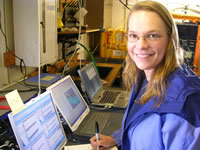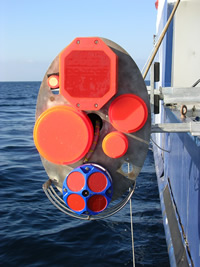


|
The Project
|
August 25, 2005
Sound The New Horizon left the dock in San Diego one week ago on in mission to map organized layers of plankton in the Monterey Bay off the coast of California. We have all adjusted to the pitch and roll of the ship on the ocean where both never stop moving. We have tuned our instruments and we have begun to look at the ocean water. Looking not across the sea horizon as most people view the ocean, but looking with the eyes and ears of transmissometers, temperature sensors, fluorometers, laser beams and transducers (acoustic sounders). It is these instruments that give us a look at the water beneath the ocean surface. We see the ocean depths on computer screens in the ship’s lab. The computers that monitor the acoustic sounds reflected off animals (fish and zooplankton) in the ocean show a continuous view of the column of water beneath the ship. Have you heard or ever used a fish finder? A device similar to this is what is being used to locate thin layers of zooplankton. Five echo sounders of different frequencies are positioned face down, off the port side of the ship. Each echo sounder monitors a slightly different size of animals. During the night while everyone is asleep the ship ‘mows the lawn’ as Chad calls it. The ship moves back and forth over a rectangular area while the echo sounders monitor the sea beneath the ship. The information (data) collected is recorded into the computer memory and is displayed on the computer screen. The screen shows the information from all five sounders on the screen. We once saw something big so we ran out on deck just in time to see a sea lion coming up from under the ship. Kelly Benoit-Bird, the lead scientist for the echo sounder portion of the trip, wakes early to replay the information collected during the night. Kelly looks for patterns in the data that represent thin layers of plankton. These layers, if spotted, will direct the collection activity for that day. Observing and recording these thin layers can help people understand the ecology (the interrelationship between organisms and their environment) of the bay. Understanding the ecology of this region can help people that use the bay for economic and recreational purposes. The thought is that these layers can be predictable if enough information is known about them. Experiment with sound, echoes, and acoustics using your radio, boom box or stereo. Play your music at a medium volume in a room closed in by four walls. The room with its four walls and all the furniture reflect the music back to your ears. Some rooms have better acoustics than others. Try putting pillows in front of the speakers. Pillows absorb rather than reflect sound. Now play the music, at the same volume, outdoors away from any walls. Without walls to reflect the sound, the sound travels straight away from the speakers and only those in the direct path of the sound will hear the sound clearly. Sound travels away from its source until it hits an object that will either absorb the sound or reflect it. Math Problem Sound travels through the air at 1000 feet per second while sound travels through water at about 5000 feet per second. How many times faster does a whale’s sound travel through water than a chimpanzee’s sound travel through air? Think about how this plays an important part in how this animal lives.
|


